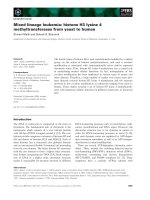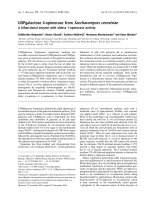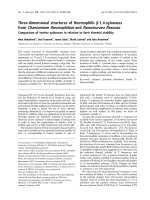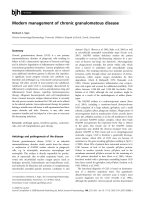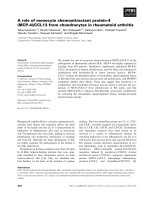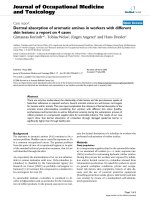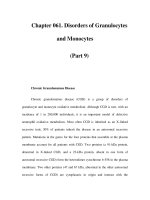4 CASES FROM SUSPECTED CHRONIC GRANULOMATOUS
Bạn đang xem bản rút gọn của tài liệu. Xem và tải ngay bản đầy đủ của tài liệu tại đây (953.77 KB, 11 trang )
JOURNAL OF MEDICAL RESEARCH
4 CASES FROM SUSPECTED CHRONIC GRANULOMATOUS
DISEASE IN THE RESPIRATORY UNIT
IN VIETNAM NATIONAL CHILDREN’S HOSPITAL
Dang Mai Lien1, , Le Thi Hong Hanh1, Trinh Thi Dung1, Nguyen Thanh Binh1,2
1
Vietnam National Children’s Hospital
2
Hanoi Medical University
Chronic granulomatous disease (CGD) is an inherited primary immunodeficiency disease which is
one kind of the phagocytic dysfunction. It is accounted for 1 : 200000 live births in the United States. The
mechanism of CGD is mutation in any structural molecules of Nicotinamid Adenine Dinucleotide Phosphate
(NADPH) oxidase. Therefore, CGD increases the body’s susceptibility to infections caused by bacteria and
fungi with granulomas formed at the sites of infection or inflammation. We report 4 cases diagnosed as
suspected CGD in patients suffering from persistent pneumonia in the respiratory unit in Vietnam National
Children’s Hospital to recommend colleagues not to mis-diagnose CGD in recurrent or persistent pneumonia.
Keywords: chronic granulomatous disease, persistent pneumonia.
I. INTRODUCTION
CGD is a rare disease which can be misdiagnosed in recurrent or persistent pneumonia.
One of the reasons is the lack of DHR test
(Dihydrorhodamine flow cytometry based test)
in the laboratory. However, Vietnam Central
Children’s hospital have had DHR test for
screening of suspected patients suffering from
CGD for approximately 1 year. Therefore, we
want to report 4 case studies diagnosed with
persistent pneumonia in patients suffering from
suspected CGD, to recommend all colleagues
not to mis-diagnose CGD in the clinical practice.
We collected clinical and sub-clinical data from
patient charts, then followed up patients after
discharged.
Corresponding author: Dang Mai Lien
Address: Vietnam National Children’s Hospital
Email:
Received day: 06/05/2020
Accepted day: 05/07/2020
178
Case 1
A 4 month-old boy who admitted to hospital
because of cough and wheezing. The patient
was treated for pneumonia from 38 days to 4
months old without improvement. Pre-history:
he was the third child with a normal birth weight
of 3.8 kg. His older sister and older brother are
healthy.
On admission, the child was suffering from
respiratory distress grade 2 with wet rales in
both lungs with hepatomegaly, splenomegaly
and lymphadenomegaly. Full blood count (FBC)
showed increased white blood cells (WBC),
especially neutrophils. Dihydrorodamine (DHR)
flow cytometry based test showed phagocytic
dysfunction in quality. Chest X-ray and Multislice computer tomography (MSCT) showed
pneumonia, lymph node in mediastinum, mild
pleural effusion. Bacteria and fungi count were
negative. The patient was treated by antibiotics
and anti-fungal drugs, then discharged home
with oxygen support.
JMR 136 (12) - 2020
JOURNAL OF MEDICAL RESEARCH
Table 1. Peripheral blood test
5th
Jan
2020
10th
Jan
16th
Jan
11th
Feb
21st
Feb
28th
Feb
9th
Mar
23rd
Mar
31st
Mar
2020
2020
2020
2020
2020
2020
2020
2020
WBC (G/l)
20.73
24.03
28.77
21.63
25.65
25.64
31.55
30.88
35.16
Neu(%)
43.5
52.9
54.4
47.3
55.7
54
57.6
62.3
62.4
Lym(%)
33
28
25.2
39.7
34.4
30
30.9
25.9
26.7
Eosin(%)
6.5
4.5
3.5
1
0.3
1.7
1.4
1.7
0.9
Baso (%)
0.1
0.2
0.1
0.1
0.2
0.4
0.3
0.2
0.2
Hb (g/l)
113
109
94
81
94
97
104
98
96
PLT (G/l)
464
446
442
465
259
364
512
491
646
CRP (mg/l)
56.26
57.33
33.34
Pro-calcitonin
(ng/ml)
0.56
0.53
0.48
0.28
patient-1 stimulated
Image 1. DHR test of case-1 showed Neutrophil dysfunction
patient-1's father
patient-1's mother
Image 2. DHR test of case 1’s parents showed normal Neutrophil function
JMR 136 (12) - 2020
179
JOURNAL OF MEDICAL RESEARCH
Table 2. Lymphocytes subset in peripheral blood
Cells
Total (cells/µL)
CD4 (TCD4)
2609.8
CD8 (TCD8)
2189.08
CD3 (Lympho T)
4940.15
CD19 (Lympho B)
1479.6
CD56 (NK cell)
158.89
Table 3. Immunoglobulin in Serum
Immunoglobulin
Concentration (g/L)
IgA
0.47
IgG
11.79
IgM
1.15
IgE
302.5
Imaging diagnostics
11th January 2020
30th March 2020
Image 3. Chest X-ray showed opacity in the right lung without improvement
MSCT lung
10th February 2020
3rd April 2020
Image 4. MSCT lung show pneumonia, does not suggest
congenital pulmonary malformation
180
JMR 136 (12) - 2020
JOURNAL OF MEDICAL RESEARCH
The pathogens of pneumonia were negative.
The patient’s bacterial culture in the nasopharyngeal and bronchoalveolar lavage (BAL)
fluid was negative; Polymerase Chain Reactive (PCR) for 7 bacteria in the respiratory tract
was negative; PCR tuberculosis was negative 3
times, Microscopic Observation Drug Susceptibility liquid culture (MODS) tuberculosis was
negative 3 times; Mycobacterium tuberculosis
(MTB) resistant to Rifampicin (RMP) expert
was negative, Quantiferon was negative.
PCR Pneumocystis pneumonia (PCP) was
negative, fungal culture was negative, test for
fungal antigen was negative.
Influenza type A, B; RSV; Adenovirus, Cytomegalovirus (CMV) were all negative.
Human Immunodeficiency Virus (HIV) Enzyme-Linked Immunosorbent Assay (ELISA)
was negative.
Bronchoscopy showed airway inflammation.
Case 2
A 4 month-old boy, admitted to hospital because of cough and fever. The child was treated for pneumonia from age 2 months old to 4
months old without improvement. Pre-history,
he was the first child, normal birth weight.
On examination, he was febrile with wet rale
in the right lung, no respiratory distress. FBC
showed increased WBC, especially neutrophils. DHR flow cytometry based test showed
phagocytic dysfunction in quality. Chest X-ray
and MSCT showed pneumonia, mild pleural
effusion. The pathogen of bacteria and fungi
were negative. The patient was then treated
with antibiotics and anti-fungal drugs and is still
an in-patient.
Table 4. Peripheral blood test
19th March
2020
31st March
2020
6th April
2020
9th April
2020
10th Apr il
2020
WBC (G/l)
47.62
26.14
24.61
20.66
28.73
neu (%)
40.8
43.8
48.7
82.5
89.3
Lympho (%)
38.2
42.6
35.4
14.6
7.4
Hb (g/dl)
109
111
109
106
109
PLT (G/l)
685
516
563
507
308
patient-2 stimulated
Image 5: DHR test of case 2 showed Neutrophil dysfunction
JMR 136 (12) - 2020
181
JOURNAL OF MEDICAL RESEARCH
patient-2's father stimulated
patient-2's mother stimulated
Image 6. DHR test of case-2's patients showed normal neotrophil function
Imaging diagnostics
9th April 2020
30th March 2020
Image 7
Image 8
19th March 2020
Image 9
Image 7,8,9. Chest X-ray showed opacity in the right lung without improvement
182
JMR 136 (12) - 2020
JOURNAL OF MEDICAL RESEARCH
The pathogens of pneumonia were negative.
The patient’s bacterial culture in the nasopharyngeal fluid was negative, PCR for 7 bacteria in the respiratory tract was negative; PCR
tuberculosis in the gastric fluid was negative 3
times, MODS tuberculosis in the gastric fluid
was negative 3 times; Acid Fast Bacillus (AFB)
tuberculosis in the gastric fluid was negative 3
times; MTB resistant to RMP expert was negative.
PCR PCP was negative, fungal culture were
negative.
Case 3
A 11 month-old boy, prehistory:
o First time: he was treated for pneumonia from age 19 days old to 7 weeks old.
o Second time: after being discharged
home for 3 weeks, he was admitted to the hospital again because of pneumonia and treated
for 4 weeks.
o Third time, patient was admitted and
treated for pneumonia and Crohn’s disease for
20 days.
o Fourth time, patient was admited and
treated for pneumonia, respiratory distress/
Table 5. Peripheral blood test
27th June
10th July
22nd July
8th August
23rd August
2019
2019
2019
2019
2019
WBC (G/l)
21.76
33.76
22.39
18.1
21.56
Neu (%)
70.3
70
67.2
45.3
52.1
Lym (%)
23.2
18
26.3
45.6
41.9
Hb (g/l)
87
97
98
109
113
PLT (G/l)
638
811
753
648
707
Image 10. DHR test of case-3 showed neutrophil dysfunction
JMR 136 (12) - 2020
183
JOURNAL OF MEDICAL RESEARCH
patient-3's father stimulated
patient-3's mother stimulated
Image 11. DHR test of case-3 parents showed normal neutrophil function
Imaging diagnostics on 23th August 2019
Image 12. Chest X-ray showed opacity in the right lung
Immuno test:IgA: 0.54 g/l, IgM: 1.34 g/l, IgG:
10.39 g/l, IgE: 6.1 g/l; CD3 cells:6244 cells/
mm3, CD4 cells: 3278 cells/mm3, CD8 cells:
2798 cells/mm3.
HIV was negative by ELISA
Case 4:
A 2.5 year-old-boy, pre-history: recurrent
pneumonia.
• Second time: 1 month later, he was treated
for pneumonia for 52 days.
• Third time: He was treated for pneumonia
and hand-foot-mouth disease when he was 24
months old.
From 24 months old till now, he was treated
for recurrent pneumonia 4 times at the hospital
without improvement.
• First time: when he was 30 days of age, he
was admitted and treated for pneumonia and
acute diarrhea for 38 days.
184
JMR 136 (12) - 2020
JOURNAL OF MEDICAL RESEARCH
Table 6. Peripheral blood tests
3rd July
10th July
25th July
6th August
2019
2019
2019
2019
WBC (G/l)
23.53
27.1
11.96
11.91
Neu (%)
12.4
18.76
7.99
5.76
Hb (g/l)
103
95
92
89
PLT (G/l)
595
664
631
759
CRP (mg/l)
47.89
118.3
119.27
138.58
DHR flow cytometry based test showed phagocytic dysfunction in quality
Table 7. Lymphocyte subset in peripheral blood
Cells
Cells/µL
CD4 (TCD4)
1487
CD8 (TCD8)
1507
CD3 cells (Lympho T)
3053
Table 8. Immunoglobulin in Serum
Immunoglobulin
Concentration (g/L)
IgA
0.86
IgG
8.75
IgM
1.57
patient-4 stimulated
Image 13. DHR test showed neutrophil dysfunction
JMR 136 (12) - 2020
185
JOURNAL OF MEDICAL RESEARCH
patient-4's father stimuated
patient-4's mother stimuated
Image 14. DHR test of case-4's father showed normal neutrophil function,
the mother's DHR test showed 2 populations
Imaging diagnostics
16th February 2019
Image 15
3rd July 2019
26th August 2019
Image 16
Image 17
186
JMR 136 (12) - 2020
JOURNAL OF MEDICAL RESEARCH
II. DISCUSSION
All 4 patients were diagnosed with recurrent and persistent pneumonia. Most of them
were diagnosed with pneumonia at an early
age (patients were diagnosed with pneumonia
when he was 19 days old, 30 days old, 38 days
old). There was a slow clinical improvement despite testing to detect the pathogens that cause
pneumonia such as bacterial, viral, fungal culture in nasopharyngeal, bronchoalveolar lavage
(BAL) fluid, bronchoscopy and imaging diagnostic as well as suitable treatment. In addition,
chest Xray and lung MSCT of 4 cases showed
opacity of the lung without improvement. Their
cell immunity was in normal range, while their
immunoglobulins were slightly increased. Marciano BE at al. (2015) examined records of 268
patients at a single center over 4 decades to
understand the impact of common severe infections in Chronic granulomatous disease
(CGD) . Aspergillus incidence was estimated at
2.6 cases per 100 patient-years; Burkholderia,
1.06 per 100 patient-years; Nocardia, 0.81 per
100 patient-years; Serratia, 0.98 per 100 patient-years, and severe Staphylococcus infection, 1.44 per 100 patient-years. Lung infection
occurred in 87% of patients.4
In addition, the increased WBC, especially neutrophils led us to the DHR (Dihydrorhodamine 123 test) which finally helped
screened for CGD. The nonfluorescent
rhodamine derivative, DHR, is taken up by
phagocytes and oxidized to a green fluorescent compound byproducts of the nicotinamide
adenine dinucleotide phosphate (NADPH) oxidase). The sensitivity and quantitative nature of
this assay make it possible to differentiate oxidase-positive from oxidase-negative phagocyte
subpopulations in CGD carriers and identify
deficiencies in gp91phox and p47phox.5 Abnormal DHR test results can be seen in other
JMR 136 (12) - 2020
diseases included G6PD (glucose-6 phosphate
dehydrogenase), myeloperoxidase deficiency
and the syndrome of synovitis, acne, pustulosis, hyperostosis, and osteitis (SAPHO).6
After the positive neutrophil-function testing,
positive findings should be confirmed by genotyping. We are waiting for the result of genotyping of case 2 which is the first child of the family.
Parents of the 3 other patients did not approve
genotyping since the siblings are healthy and
genotyping is an expensive test.
1 of 4 patients was misdiagnosed as Crohn’s
disease which is the differential diagnosis to
CGD.7
In addition, one patient was diagnosed for
CGD when he was 2.5 years old. He was treated for pneumonia twice including the first time
of admission when he was 30 days old of age
and the second time when he was 3 months
old; afterward, he was healthy for 6 months.
CD3, CD4, CD8 and IgA, IgG, IgM tested were
in the normal range. WBC decreased from high
to normal range due to treatment response
which explained why the patient was diagnosed
for CGD later than the 3 other patients. In this
case, we try to exclude MTB which was the
cause of pneumonia by doing a bronchoscopy,
then test the BAL in our hospital and at the Lung
Center Hospital. Both results were negative.
Successful hematopoietic cell transplantation (HCT) is a definitive cure for CGD.8 Success increases and morbidity and mortality are
reduced, early HCT becomes a desirable and
appropriate choice for patients with CGD. The
estimated HCT event-free survival rate for patients with CGD is > 80 percent; overall survival
is approximately 90 percent, with improved the
quality of life and transplant outcomes continues to improve.9 However, in Viet Nam, HCT is
very costly, from hundreds of millions to one or
187
JOURNAL OF MEDICAL RESEARCH
two billion Vietnamese dong, and is only partially reimbursed by health insurance. The cost is
too high for many families with patients suffering from immunodeficiency diseases to pursue
extended treatment. Consequently, it remains
the largest barrier for patients to approach root
treatment.
III. CONCLUSION
Chronic granulomatous disease is a rare
primary immunodeficiency disease, easily misdiagnosed. Patients are susceptible to bacterial, fungal, and tuberculosis infections, anemia,
slow growth, and slow wound healing. Symptoms are evident in many systems including respiratory, digestive, urogenital, skin, eyes, and
mouth.
As CGD can be shown in many organs and
since physicians are not familiar with the DHR
test, the diagnosis can be missed. Therefore,
as presented in the aforementioned 4 cases
study, we recommend to implement the DHR
test in children with severe, recurrent and persistent infections to attain appropriate diagnosis
and treatment plan.
REFERENCES
1. Holland S.M. and Rosenweig S. (2013).
Chronic granulomatous disease: Pathogenesis,
clinical manifestations, and diagnosis. UptoDate,
1–24,< />chronic-granulomatous-disease-pathogenesis-clinical-manifestations-and-diagnosis?source=autocomplete&index=1~2&search=cgd>, accessed: 20/05/2020.
2. Winkelstein J.A., Marino M.C., Johnston
R.B. et al. (2000). Chronic granulomatous disease: Report on a national registry of 368 patients. Medicine (Baltimore), 79(3), 155–169.
3. Mortaz E., Azempour E., Mansouri D. et
al. (2019). Common Infections and Target Or188
gans Associated with Chronic Granulomatous
Disease in Iran. International Archives of Allergy and Immunology, 179, 62–73.
4. B.E. M., C. S., A. F. et al. (2015). Common severe infections in chronic granulomatous disease. Clinical Infectious Diseases,
60, 1176–1183, < />search/results?subaction=viewrecord& from=export&id=L603668720%5Cnhttp://
dx.doi.org/10.1093/cid/ciu1154>,
accessed:
22/05/2020.
5. Kuhns D.B., Alvord W.G., Heller T. et al.
(2010). Residual NADPH oxidase and survival
in chronic granulomatous disease douglas. N
Engl J Med, 363(27), 2600–2610.
6. Mauch L., Lun A., O’Gorman M.R.G. t al.
(2007). Chronic granulomatous disease (CGD)
and complete myeloperoxidase deficiency both
yield strongly reduced dihydrorhodamine 123
test signals but can be easily discerned in routine testing for CGD. Clin Chem, 53(5), 890–
896.
7. Khangura S.K., Kamal N., Ho N. et al.(
2016). Gastrointestinal Features of Chronic
Granulomatous Disease Found During Endoscopy. Clin Gastroenterol Hepatol, 14(3), 395402.e5.
8. Güngör T., Teira P., Slatter M. et al.
(2014). Reduced-intensity conditioning and
HLA-matched haemopoietic stem-cell transplantation in patients with chronic granulomatous disease: A prospective multicentre study.
Lancet, 383(9915), 436–448.
9. Connelly J.A., Marsh R., Parikh S. et al.
(2018). Allogeneic Hematopoietic Cell Transplantation for Chronic Granulomatous Disease:
Controversies and State of the Art. J Pediatric
Infect Dis Soc, 7(Suppl 1), S31.
JMR 136 (12) - 2020
